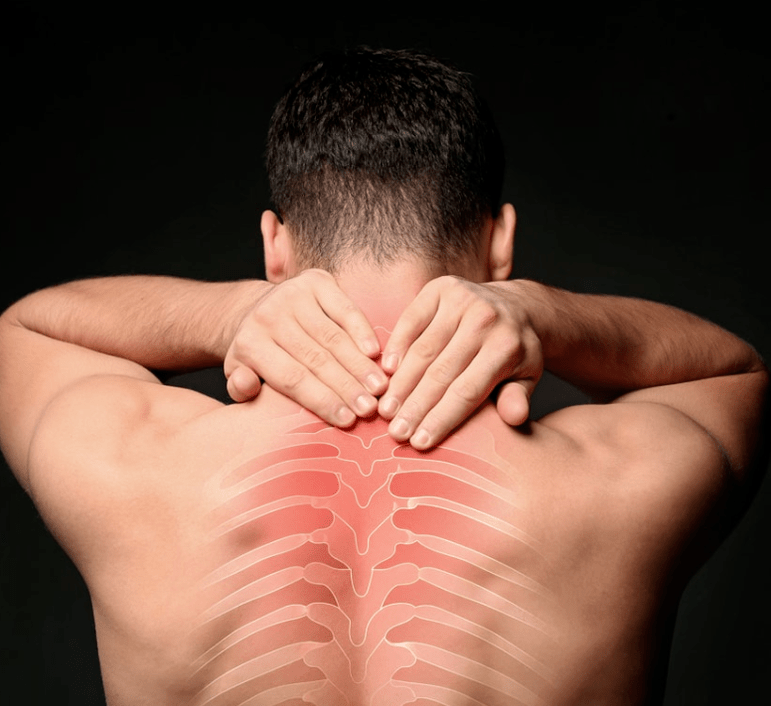
Osteochondrosis is the most common disease of all spinal disorders. As osteochondrosis is directly a dystrophic-degenerative lesion of the discs located between the vertebrae, then, as a consequence, it leads to an irreversible change in its structure, as well as in the shape of the discs themselves, which make up the thoracic spine. .
As a person ages, these changes in their spine develop more and more, and by age 40-45, almost everyone suffers from osteochondrosis of the spine. By itself, osteochondrosis of the thoracic spine develops much less frequently than, for example, the lumbar or cervical spine, as the vertebrae are much less mobile than in other vertebral areas. In addition, the back area in the chest region has a more developed corset of muscles, which supports the spine in the thoracic region much better than in others.
What is this thoracic osteochondrosis?
Thoracic osteochondrosisit directly represents a stratification of the discs between the vertebrae, with a simultaneous decrease in their thickness and, as a consequence, the subsequent clamping of the nerve endings located in the intercostal area of the human thorax.
However, we note once again that, due to the fact that physiological fixation by the ribs in humans is quite rigid, the spine in the chest region is less susceptible to osteochondrosis. Thoracic osteochondrosis is a rare phenomenon, for example, cervical or lumbar osteochondrosis.
Typically, with osteochondrosis of the thoracic spine, the pathological process involves the discs between the vertebrae of the thoracic spine, which includes twelve thoracic vertebrae. But more often, with osteochondrosis of the thoracic region, pathological changes occur in the upper thoracic vertebrae. There are varying degrees of injury with thoracic osteochondrosis, and we will consider them in more detail later.
Predisposing factors for the development of thoracic osteochondrosis
The exact causes of the occurrence of osteochondrosis in the thoracic region have not yet been fully established by modern science. Currently, it is customary to distinguish in medicine the following predisposing factors, or so-called risk factors, by which osteochondrosis of the thoracic region of the spine occurs:
- hereditary predisposition;
- excessive physical activity in this section of the spine;
- spinal cord injury, such as falls or bruises in the chest region;
- changes that occur with age in the intervertebral discs and lead to decreased hydration of the disc tissues;
- disturbances of the blood supply in the chest area.
Causes contributing to thoracic osteochondrosis disease
In general, the development of the disease with osteochondrosis is generally promoted by hypodynamics, that is, lack of muscle loads, leading to a weakening of the muscle corset functions and, consequently, to an increase in loads on the discs and intervertebral ligaments.
Additional reasons for the development of thoracic osteochondrosis are:
- body hypothermia;
- the presence of chronic stressful situations;
- transferred infections;
- difficult physical work conditions;
- hormonal disorders arising in the body;
- violation of the metabolic process in the body;
- the presence of congenital defects of the spine, namely its thoracic region.
In the course of exposure to a combination of these factors, or sometimes even one, irreversible dystrophic-degenerative processes develop in the discs between the vertebrae over time:
- the nucleus pulposus of the intervertebral disc gradually begins to lose fluid, which has been secreted by them to provide a lubricating function, which ultimately significantly reduces the damping function of that disc;
- the fibrous ring of the vertebrae itself, due to the increased load on it, becomes more vulnerable, which in turn leads to its gradual destruction.
Symptoms and Signs of Thoracic Spinal Osteochondrosis
The clinical symptoms of thoracic osteochondrosis depend entirely on the following factors:
- the patient's age;
- the degree of affection of the disease;
- stages of osteochondrosis of the thoracic spine: remission or exacerbation.
The main signs of thoracic osteochondrosis are:
- chest pain in the spine, the so-called dorsago;
- painful damage to the nerve endings of the spinal cord - radiculopathy;
- abdominal syndrome;
- cardiac syndrome or changes in the heart muscle, with characteristic pain that persists even under the influence of trinitroglycerin;
- pulmonary syndrome, in the form of stagnation in the lungs with signs of hypoxia, ie, asphyxia.
There is no increase in body temperature in patients with thoracic osteochondrosis, which is also a direct differential diagnostic sign. Back pain in the thoracic region as one of the main symptoms of osteochondrosis indicates the occurrence of fissures in the annulus fibrosus and deformation of the nucleus pulposus. When palpating, the pain in this region of the chest only intensifies, the symptoms increase.
In addition, the characteristic symptoms of thoracic osteochondrosis with compression myelopathy, that is, deformation of nerve endings, are:
- "shivering" feeling - paresthesia;
- pain along the pinched nerve - these are common symptoms;
- decreased sensitivity to temperature and touch;
- spinal motor function disorders are also one of the characteristic symptoms.
Having encountered these symptoms, you need to see a specialist. The appearance of symptoms in the complex and their intensity are especially dangerous. At the same time, it is not appropriate to treat symptoms without eradicating the causes and factors of the disease.
Grades of disease with thoracic osteochondrosis
Each degree of disease with thoracic osteochondrosis is characterized by its own pathology, which has only its own clinical signs. Modern medicine distinguishes four degrees of degenerative disc disease of the thoracic region (similarly - degenerative disc disease of the lumbar and cervical disc) and, consequently, four periods of its development. Let's consider them in more detail.
First degree,for which it is characteristic that fissures appear within the annulus fibrosus, into which the nucleus pulposus subsequently penetrates. This period of development of the disease with thoracic osteochondrosis is characterized by the following symptoms:
- the appearance of pain in the spine that does not go beyond the location of the lesion;
- these pains may be permanent or expressed by lumbago;
- there may be a convulsive contraction of the muscles in the chest region, accompanied by pain in the heart region.
High schoolthe development of thoracic osteochondrosis is characterized by the pathological occurrence of increased intervertebral mobility with the following clinical manifestations:
- subluxations appear in the thoracic spine;
- pain increases during movement;
- discomfort appears with prolonged posture.
Third degreecharacterized by rupture of the fibrous ring and outflow of the nucleus pulposus beyond its limits. In this period of the disease with osteochondrosis of the thoracic spine, intervertebral hernias begin to appear, whose clinical signs are quite severe. Namely - neurovascular, muscle tonic and reflex dystrophic.
In addition to the above, for the third degree of osteochondrosis of the thoracic region, an alteration in the following spinal conditions is characteristic:
- poor fixation of the position of the spine;
- limitation of mobility in the spinal region, manifested in the form of kyphosis or scoliosis.
fourth degree- the dystrophic-degenerative process already affects all structures that surround the spine. This pathological process involves the yellow, interspinous and other ligaments, and fibrosis occurs in structures around the spine. During this period of the disease with thoracic osteochondrosis, the so-called state of remission is clinically observed.
complications
With the progression of the disease with thoracic osteochondrosis, the development of concomitant complications is possible:
- inflammation of the nerve endings in the spinal cord;
- the occurrence of intervertebral hernias;
- development of vascular dystonia;
- the development of Schmorl's hernia;
- spondyloarthritis disease;
- pathological growth of bone growths - osteophytes;
- a significant decrease in the spinal canal.
It should be noted that the severity of complications arising from thoracic osteochondrosis depends entirely on the rate of progression of the disease process that has arisen and, of course, on the effectiveness of the methods for treating osteochondrosis of the thoracic spine.
Diagnosis and its methods

In practice, several methods are used to diagnose thoracic osteochondrosis. Of these, the most common is the X-ray exam, the results of which are quite informative. The signs of thoracic osteochondrosis detected in this study are as follows:
- the contours of the discs between the vertebrae are broken off;
- the edges of the integumentary plates acquired a wavy character;
- the intervertebral discs changed shape;
- osteophytes appeared - pathological bone growths in the spine;
- the hook-shaped processes of the vertebrae widened and sharpened;
- the bodies of the thoracic vertebrae changed their normal shape;
- the height of the discs between the vertebrae significantly decreased;
- herniated disc between the formed vertebrae.
In some cases, a method of diagnosing thoracic osteochondrosis of the spine is practiced through an X-ray contrast study, which determines the following signs of this disease:
- in the case of advanced pathology, the contrast agent completely fills the disc between the vertebrae;
- with the help of a contrast agent, the contours of the nucleus pulposus are visible, which are uneven;
- when the intervertebral disc is destroyed, the contrast agent penetrates far beyond its limits, until it penetrates the spinal canal.
Only the correct diagnosis can determine the correct treatment.
Osteochondrosis Treatment
The treatment of thoracic osteochondrosis is possible in one of the following ways, used taking into account the results of diagnoses of thoracic osteochondrosis, namely:
- traditional conservative treatment of the spine;
- treatment of thoracic osteochondrosis with traction;
- operative surgical intervention.
The treatment of thoracic osteochondrosis, called conservative, is complex for the treatment of any type of osteochondrosis: medications, physiotherapy, physical therapy exercises. Nonsteroidal anti-inflammatory drugs aim to relieve back pain, known as thoracic osteochondrosis. It should be noted that these medications very well eliminate the inflammatory processes, as well as the resulting swelling, helping to reduce the compression of the nerve roots. In more complex cases of breast osteochondrosis, the treating physician may prescribe a number of additional medications, for example, some powerful analgesics and muscle relaxants that block the onset of muscle spasms.
When the pain subsides or is able to stop, that is, during remission, physiotherapeutic treatment is prescribed, in addition to physiotherapy and massage. These are all important components of a comprehensive treatment. One of the main physical therapy tools for the treatment and prevention of the disease is pulsed magnetic therapy with special medical devices for clinical and home use.
Only magnetotherapy with special parameters is allowed for use during exacerbations; there are medical devices to deal with acute and chronic pain. This system is also suitable for treating the lumbosacral and cervical spine.
In addition to the above, traction treatment, that is, the treatment of thoracic osteochondrosis by means of special traction, can be successfully used in the treatment of thoracic osteochondrosis. With this method, the muscles, tissues and paravertebral ligaments are stretched, which leads to an increase in the intervertebral distance. Even a millimeter and a half will be enough to reduce swelling, eliminate compression, and relieve tension in the muscles adjacent to the spine. In any case, the fundamental principle of conservative treatment is its complexity. The treatment will have to be long and regular, only in this way to have hope of results.
But surgical intervention as a type of treatment for osteochondrosis is advisable only when the above methods of treating thoracic osteochondrosis do not give the desired result.





































